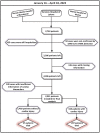Inflammatory biomarkers and cardiac injury in COVID-19 patients
- PMID: 36505005
- PMCID: PMC9729944
- DOI: 10.3389/fpubh.2022.1024535
Inflammatory biomarkers and cardiac injury in COVID-19 patients
Abstract
Introduction: Cardiac injury has received considerable attention due to the higher risk of morbidity and mortality associated with coronavirus disease. However, in a developing country, there is a scarcity of data on cardiac injury in COVID-19 patients related to inflammatory biomarkers.
Methods: Therefore, the present research retrospectively analyzes data from three territorial hospitals in Pakistan's Punjab province to investigate the potential impact of the cardiac injury on the mortality and severity of COVID-19-infected patients. We evaluated 2,051 patients between January 16 and April 18, 2022, with confirmed COVID-19. The in-hospital mortality recorded for the selected sample size was about 16.28%.
Results: The majority of the participants were identified as male (64%) with a median age of 65 years. Also, fever, fatigue, and dyspnea were reported as common symptoms. An aggregate of 623 patients (30.38%) had a cardiac injury, and when these patients are compared to those without cardiac injury, the participants were significantly older and had more comorbidities with higher leukocyte counts, elevated levels of C-reactive protein, interleukin-6, procalcitonin, myohemoglobin, creatinine kinase-myocardial band, serum creatinine, high-sensitivity troponin-I, N-terminal pro-B-type natriuretic peptide had a significant amount of multiple ground-glass opacity and bilateral pulmonary infiltration in radiographic results. Participants with heart injury required more non-invasive or invasive mechanical respiration than those who did not have a cardiac injury. Individuals with cardiac injury had higher rates of sepsis, acute respiratory distress syndrome (ARDS), d-dimer concentration, and respiratory failure than those without cardiac injury. Patients who had had a cardiac injury died at a higher rate than those who had not suffered cardiac damage. In the multivariable logistic regression analysis, participants with cardiac injury showed greater odds of COVID-19 mortality and were found associated with older age (OR = 1.99, 95% CI = 0.04-3.19), elevated cardiac troponin I (OR = 18.64, 95% CI = 13.16-23.01), the complication of sepsis (OR = 10.39, 95% CI = 7.41-13.39) and ARDS (OR = 6.65, 95% CI = 4.04-8.91).
Conclusion: Cardiac injury is a frequent complication among patients with coronavirus-induced infection in Punjab, Pakistan, and it is significantly linked to a greater risk of in-hospital mortality.
Keywords: COVID-19; SARS-CoV-2; cardiac biomarkers; cardiac injury; coagulation biomarkers; inflammatory biomarkers; mortality; severe patients.
Copyright © 2022 Mumtaz, Rehman, Rahaman and Rehman.
Conflict of interest statement
The authors declare that the research was conducted in the absence of any commercial or financial relationships that could be construed as a potential conflict of interest.
Similar articles
-
Association of Cardiac Injury With Mortality in Hospitalized Patients With COVID-19 in Wuhan, China.JAMA Cardiol. 2020 Jul 1;5(7):802-810. doi: 10.1001/jamacardio.2020.0950. JAMA Cardiol. 2020. PMID: 32211816 Free PMC article.
-
Clinical characteristics of 113 deceased patients with coronavirus disease 2019: retrospective study.BMJ. 2020 Mar 26;368:m1091. doi: 10.1136/bmj.m1091. BMJ. 2020. PMID: 32217556 Free PMC article.
-
Longitudinal correlation of biomarkers of cardiac injury, inflammation, and coagulation to outcome in hospitalized COVID-19 patients.J Mol Cell Cardiol. 2020 Oct;147:74-87. doi: 10.1016/j.yjmcc.2020.08.008. Epub 2020 Aug 20. J Mol Cell Cardiol. 2020. PMID: 32827510 Free PMC article.
-
COVID-19 and cardiac injury: clinical manifestations, biomarkers, mechanisms, diagnosis, treatment, and follow up.Expert Rev Anti Infect Ther. 2021 Mar;19(3):345-357. doi: 10.1080/14787210.2020.1822737. Epub 2020 Sep 28. Expert Rev Anti Infect Ther. 2021. PMID: 32921216 Review.
-
Clinical Characteristics and Morbidity Associated With Coronavirus Disease 2019 in a Series of Patients in Metropolitan Detroit.JAMA Netw Open. 2020 Jun 1;3(6):e2012270. doi: 10.1001/jamanetworkopen.2020.12270. JAMA Netw Open. 2020. PMID: 32543702 Free PMC article. Review.
Cited by
-
Nrf2 mediated signaling axis in sepsis-induced cardiomyopathy: potential Pharmacological receptor.Inflamm Res. 2025 Apr 29;74(1):76. doi: 10.1007/s00011-025-02037-0. Inflamm Res. 2025. PMID: 40299042 Review.
-
Potential determinants of vaccine hesitancy among celiac disease patients: a single cohort analysis.Front Public Health. 2023 Aug 8;11:1061617. doi: 10.3389/fpubh.2023.1061617. eCollection 2023. Front Public Health. 2023. PMID: 37614445 Free PMC article.
-
Exploring the potential impact of group identity on post-traumatic growth in the aftermath of Corona outbreak: function of social-emotional competence as a mediator.Front Public Health. 2023 Oct 12;11:1282462. doi: 10.3389/fpubh.2023.1282462. eCollection 2023. Front Public Health. 2023. PMID: 37900048 Free PMC article.
-
Association of New-Onset Atrial Fibrillation With All-Cause Mortality in COVID-19 Patients.Cureus. 2023 Dec 1;15(12):e49785. doi: 10.7759/cureus.49785. eCollection 2023 Dec. Cureus. 2023. PMID: 38058521 Free PMC article.
-
Potential impacts of Russo-Ukraine conflict and its psychological consequences among Ukrainian adults: the post-COVID-19 era.Front Public Health. 2023 Sep 28;11:1280423. doi: 10.3389/fpubh.2023.1280423. eCollection 2023. Front Public Health. 2023. PMID: 37841733 Free PMC article.
References
MeSH terms
Substances
LinkOut - more resources
Full Text Sources
Medical
Research Materials
Miscellaneous


